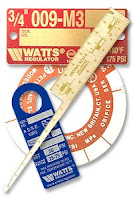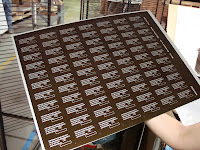By Wil Lington
This is our Second Edition of How It’s Made and this time we will show you how a chemically etched nameplate is made. We recommend this type of long-lasting nameplate for harsh indoor and/or outdoor applications where exposure to weather, temperature extremes, sunlight, chemicals, solvents, fuels and lubricants is possible. Images are chemically etched into the substrate surface and can be filled with paint for added aesthetic and functional value.
This process starts with an image of the part on a film that gets burned onto a screen. This will be set up by a printer who screens it on a printing press. Below you will see a picture of one of Sunset Decks Inc. brass, etched-and-filled nameplate screens.

Next a printer sets up the screen in the press and gets ready to start printing the part on a thin sheet of brass.
We use a special ink called resist which covers the parts of the sheet that we do not want to be etched away. Once printed the sheets are then left in a rack for a period of time before they make it to the next department to get put through our etching machine.
Next the sheets are pulled from the rack and inserted into the etch unit which then goes through various chemical and rinse stations via a conveyorized belt contained within.
Below you will see a close up over one of the rinse stations as sheets are passing through.
Once they go through the etch unit the next stop is the painting room. This step is only for etch-and-filled nameplates, customer parts that do not wish to have the etched areas of their nameplate filled in with a color would go directly to the relieving room.
The sheets are next submerged in a special chemical that helps to loosen up the hardened resist printed on the sheet, enough for us to be able to scrape it off. But getting the sheet completely clean is a 3 step process as you will see below.
First Soak & Scraping:
Lastly the etched and cleaned sheets flow out to our Mechanical Department where each piece is cut out of the sheet per the specified dimensions. Below you will see the final product:

And once again from The Willington Companies that’s……. HOW IT’S MADE.





